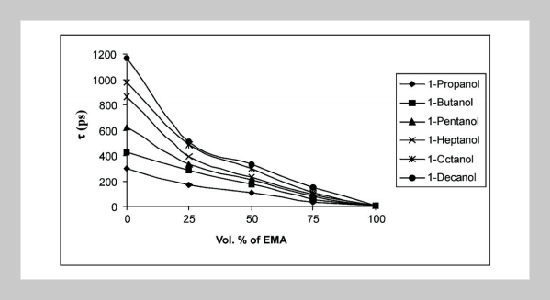REFERENCES
- [1] Schildknecht, C. E., Vinyl and Related Polymers, Wiley, New York (1977).
- [2] Savage, P. E., “Organic Chemical Reactions in Supercritical Water,” Chem. Rev., Vol. 99, pp. 603621 (1999).
- [3] Shirke, R. M., Chaudhari, A., More, N. M. and Patil, P. B., “Dielectric Measurements on Methyl Acetate + Alcohol Mixtures at (288, 298, 308, and 318) K Using the Time Domain Technique,” J. Chem. Eng. Data, Vol. 45, pp. 917919 (2000).
- [4] Chaudhari, A., Shirke, R. M., More, N. M. and Patil, P. B., “Dielectric Study of n-Butyl AcetateAlcohol Mixtures by Time-Domain Reflectometry,” J. Sol. Chem., Vol. 31, pp. 305315 (2002).
- [5] Shirke, R. M., Chaudhari, A., More, N. M. and Patil, P. B., “Temperature Dependent Dielectric Relaxation Study of Ethyl Acetate – Alcohol Mixtures Using Time Domain Technique,” J. Mol. Liq., Vol. 94, pp. 2736 (2001).
- [6] Chaudhari, A. and Mehrotra, S. C., “Dielectric Relaxation Study of Pyridine-Alcohol Mixtures using Time Domain Reflectometry”, Mol. Phys., Vol. 100, pp. 39073913 (2002).
- [7] Patil, S. P., Chaudhari, A. S., Lokhande, M. P., Lande, M. K., Shankarwar, A. G., Helambe, S. N., Arbad, B. R. and Mehrotra, S. C., “Dielectric Measurements of Aniline and Alcohol Mixtures At 283, 293, 303, and 313 K Using the Time Domain Technique,” J. Chem. Eng. Data, Vol. 44, pp. 875878 (1999).
- [8] Balamurugan, D., Kumar, S. and Krishnan, S., “Dielectric Relaxation Studies of Higher Order Alcohol Complexes with Amines using Time Domain Reflectometry,” J. Mol. Liq., Vol. 122, pp. 1114 (2005).
- [9] Sivagurunathan, P., Dharmalingam, K. and Ramachandran, K., “Molecular Interaction Studies of Acrylic Esters with Alcohols,” Indian J. Pure Appl. Phys., Vol. 43, pp. 905910 (2005).
- [10] Sivagurunathan, P., Dharmalingam, K. and Ramachandran, K., “Hydrogen Bonding Interaction between Methyl Methacrylate and Alcohols,” Z. Phys. Chem., Vol. 219, pp. 16351638 (2005).
- [11] Dharmalingam, K., Ramachandran, K. and Sivagurunathan, P., “FTIR Study of Molecular Interaction in Butyl Methacrylate-Organic Solvents Mixtures,” Z. Phys. Chem., Vol. 220, pp. 739748 (2006).
- [12] Sivagurunathan, P., Dharmalingam, K. and Ramachandran, K., “Molecular Interaction Studies of Acrylic Esters with 1-Alcohols,” Spectrochim. Acta, Vol. 64A, pp. 127129 (2006).
- [13] Dharmalingam, K., Ramachandran, K. and Sivagurunathan, P., “Hydrogen Bonding Interaction between Ethyl Methacrylate and Alcohols in Non-Polar Solvents: An FTIR Study,” Main Group Chemistry, Vol. 4, pp. 241246 (2005).
- [14] Dharmalingam, K. and Ramachandran, K., “Solvent Effects on Hydrogen Bonding between 1-Pentanol and Butyl Methacrylate”, Phys. Chem. Liq., Vol. 44, pp. 7781 (2006).
- [15] Sivagurunathan, P., Dharmalingam, K. and Ramachandran, K., “Molecular Interaction Studies of NPropanol with Methyl Methacrylate in Inert Solvents,” Indian J. Phys., Vol. 79, pp. 14031405 (2005).
- [16] Dharmalingam, K., Ramachandran, K. and Sivagurunathan, P., “Hydrogen Bonding Interaction between Acrylic Esters and Monohydric Alcohols in Non-Polar Solvents: An FTIR Study,” Spectrochim. Acta, Vol. 66A, PP. 4851 (2007).
- [17] Sivagurunathan, P., Dharmalingam, K. and Ramachandran, K., “Solvent Effects on Hydrogen Bonding between Ethyl Methacrylate and 1-Butanol,” Z. Phys. Chem., Vol. 219, pp. 13851390 (2005).
- [18] Sivagurunathan, P., Dharmalingam, K. Ramachandran, K. and Kalamse, G. M., “Hydrogen Bonding between Alcohols and N,N-Dimethylformamide: An FTIR Study,” Main Group Chemistry, Vol. 5, pp. 8994 (2006).
- [19] Vogal, A. I., Text Book of Practical Organic Chemistry, 3rd edition, Longman, London (1957).
- [20] Samulon, H. A., “Spectrum Analysis of Transient Response Curves,” Proc.IRE, Vol. 39, pp. 175186 (1951).
- [21] Shannon, C. E., “Communication in the Presence of Noise,” Proc.IRE, Vol. 37, pp. 1021 (1949).
- [22] Cole, R. H., Berbarian, J. G., Mashimo, S., Chryssikos, G., Burns, A. and Tombari, E., “Time Domain Reflection Methods for Dielectric Measurements to 10 GHz,” J. Appl. Phys., Vol. 66, pp. 793802 (1989).
- [23] Debye, P., Polar Molecules, Chemical Catalog, New York (1929).
- [24] Bevington, P. R., Data Reduction and Error Analysis for the Physical Sciences, Mc Graw-Hill, New York (1969).
- [25] Sivagurunathan, P., Dharmalingam, K., Ramachandran, K., Prabhakar Undre, B., Khirade, P. W. and Mehrotra, S. C., “Dielectric Relaxation Study of Alkyl Methacrylates + 1-Alcohols Mixtures using Time Domain Reflectometry,” Phil. Mag. Lett., Vol. 86, pp. 291300 (2006).
- [26] Bruggeman, D. A. G., “The Calculation of Various Physical Constants of Heterogeneous Substances. I. The Dielectric Constants and Conductivities of Mixtures Composed of Isotropic Substances,” Ann. Phys. (Leipz.), Vol. 24, pp. 636664 (1935).
- [27] Sivagurunathan, P., Dharmalingam, K., Ramachandran, K., Prabhakar Undre, B., Khirade, P. W. and Mehrotra, S. C., “Dielectric Study of Butyl Methacrylate-Alcohol Mixtures by Time Domain Reflectometry, Physica B, Vol. 387, pp.203207 (2007).
- [28] Kirkwood, J. G., “The Dielectric Polarization of Polar Liquids,” J. Chem. Phys., Vol. 7, pp. 911919 (1939).
- [29] Kumbharkhane, A. C., Puranik, S. M. and Mehrotra, S. C., “Structural Study of Amide-Water Mixtures using Dielectric Relaxation Technique,” J. Mol. Liq., Vol. 51, pp. 261277 (1992).
















